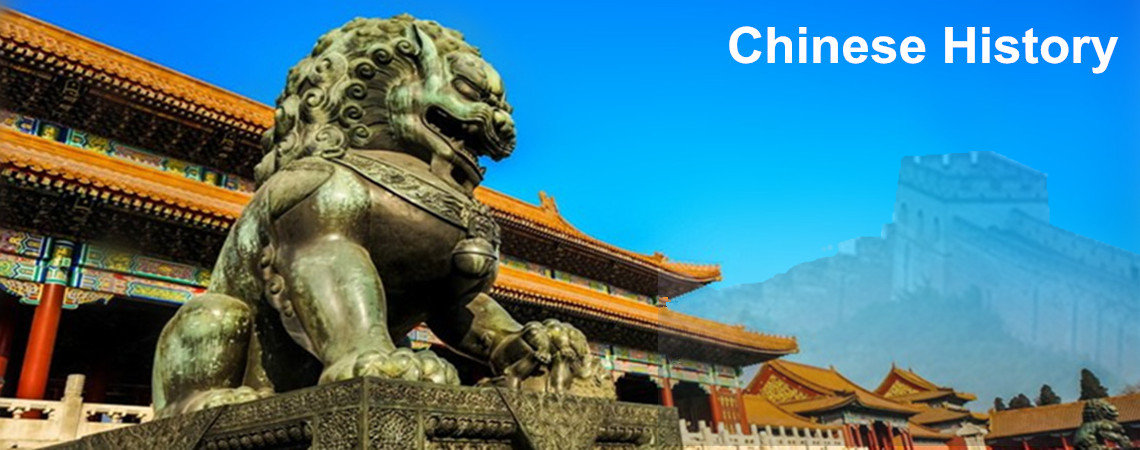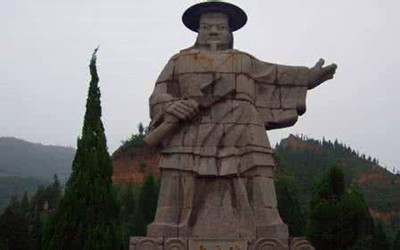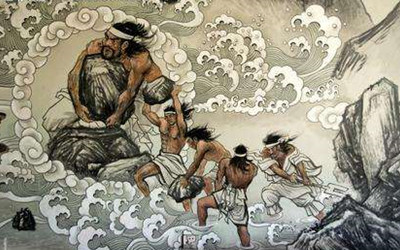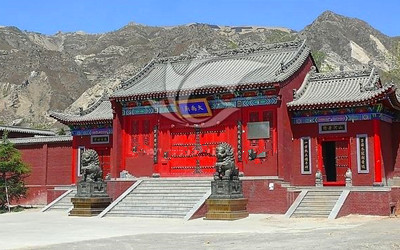
The Great Yu 大禹
 stories about Yu were collected in Sima Qian's famous Records of the Grand Historian. Yu and other "sage-kings" of Ancient China were lauded for their virtues and morals by Confucius and other Chinese teachers.Yu is one of the few Chinese rulers posthumously honored with the epithet "the Great".
stories about Yu were collected in Sima Qian's famous Records of the Grand Historian. Yu and other "sage-kings" of Ancient China were lauded for their virtues and morals by Confucius and other Chinese teachers.Yu is one of the few Chinese rulers posthumously honored with the epithet "the Great".
Early life of the Great Yu
According to several ancient Chinese records, Yu was the 8th great-grandson of the Yellow Emperor.When Yu was a child, his father Gun moved the people east toward the Central Plain of China. Empeor Yao enfeoffed Gun as lord of Chong, usually identified as the middle peak of Mount Song. Yu is thus believed to have grown up on the slopes of Mount Song in Henan Province, just south of the Yellow River.He later married a woman from Mount Tu (塗山).They had a son named Qi, a name literally meaning "revelation".
Legend of the Great Yu
During the reign of king Yao, the Chinese heartland was frequently plagued by floods that prevented further economic and social development. Yu's father, Gun, was tasked with devising a system to control the flooding.  He spent more than nine years building a series of dikes and dams along the riverbanks, but all of this was ineffective, despite (or because of) the great number and size of these dikes and the use of a special self-expanding soil. As an adult, Yu continued his father's work and made a careful study of the river systems in an attempt to learn why his father's great efforts had failed.
He spent more than nine years building a series of dikes and dams along the riverbanks, but all of this was ineffective, despite (or because of) the great number and size of these dikes and the use of a special self-expanding soil. As an adult, Yu continued his father's work and made a careful study of the river systems in an attempt to learn why his father's great efforts had failed.
Collaborating with Houji, a semi-mythical agricultural master about whom little is concretely known, Yu successfully devised a system of flood controls that were crucial in establishing the prosperity of the Chinese heartland. Instead of directly damming the rivers' flow, Yu made a system of irrigation canals which relieved floodwater into fields, as well as spending great effort dredging the riverbeds. Yu is said to have eaten and slept with the common workers and spent most of his time personally assisting the work of dredging the silty beds of the rivers for the thirteen years the projects took to complete. The dredging and irrigation were successful, and allowed ancient Chinese culture to flourish along the Yellow River, Wei River, and other waterways of the Chinese heartland. The project earned Yu renown throughout Chinese history, and is referred to in Chinese history as "Great Yu Controls the Waters"
In particular, Mount Longmen along the Yellow River had a very narrow channel which blocked water from flowing freely east toward the ocean. Yu is said to have brought a large number of workers to open up this channel, which has been known ever since as "Yu's Gateway" .
Nine Provinces
King Shun, who reigned after Yao, was so impressed by Yu's engineering work and diligence that he passed the throne to Yu instead of to his own son. Yu is said to have initially declined the throne, but was so popular with other local lords and chiefs that he agreed to become the new emperor, at the age of fifty-three. He established a capital at Anyi (安邑), the ruins of which are in modern Xia County in southern Shanxi Province, and founded what would be called the Xia Dynasty, traditionally considered China's first dynasty.
Yu's flood control work is said to have made him intimately familiar with all regions of what was then Han Chinese territory. According to his Yu Gong treatise in the Book of Documents, Yu divided the Chinese "world" into nine zhou or provinces. These were Jizhou (冀州), Yanzhou (兗州), Qingzhou (青州), Xuzhou (徐州), Yangzhou (揚州), Jingzhou (荊州),Yuzhou (豫州), Liangzhou (梁州) and Yongzhou (雍州).
Founder of the Xia Dynasty
 Yu ruled the Xia Dynasty for forty-five years and he died from an illness.It is said that he died at Mount Kuaiji, south of present-day Shaoxing, while on a hunting tour to the eastern frontier of his empire, and was buried there. The Yu mausoleum (大禹陵) known today was first built in the 6th century CE (Southern and Northern Dynasties period) in his honor.It is located four kilometers southeast of Shaoxing city.Most of the structure was rebuilt many times in later periods. The three main parts of the mausoleum are the Yu tomb (禹陵), temple (禹廟) and memorial (禹祠).In many statues he is seen carrying an ancient hoe (耒耜). A number of emperors in imperial times travelled there to perform ceremonies in his honor, notably Qin Shi Huang.
Yu ruled the Xia Dynasty for forty-five years and he died from an illness.It is said that he died at Mount Kuaiji, south of present-day Shaoxing, while on a hunting tour to the eastern frontier of his empire, and was buried there. The Yu mausoleum (大禹陵) known today was first built in the 6th century CE (Southern and Northern Dynasties period) in his honor.It is located four kilometers southeast of Shaoxing city.Most of the structure was rebuilt many times in later periods. The three main parts of the mausoleum are the Yu tomb (禹陵), temple (禹廟) and memorial (禹祠).In many statues he is seen carrying an ancient hoe (耒耜). A number of emperors in imperial times travelled there to perform ceremonies in his honor, notably Qin Shi Huang.







 Ask Questions ?
Ask Questions ?